Comprehensive Analysis of the Australian Tomato Market: Economics
VerifiedAdded on 2020/03/01
|7
|1345
|40
Report
AI Summary
This report provides an economic analysis of the tomato market, focusing on the factors influencing price fluctuations in Australia. It examines the impact of consumer preference changes, limited arable land, and supply chain disruptions. The report explores the concept of price elasticity of demand for tomatoes and calculates its impact on revenue. Furthermore, it assesses the government's role in ensuring long-term supply, considering strategies such as insurance subsidies, technological advancements like hydroponic farming, and tax breaks. The analysis highlights the challenges and potential solutions to maintain a stable and sustainable tomato market in the face of climate change and other economic pressures.
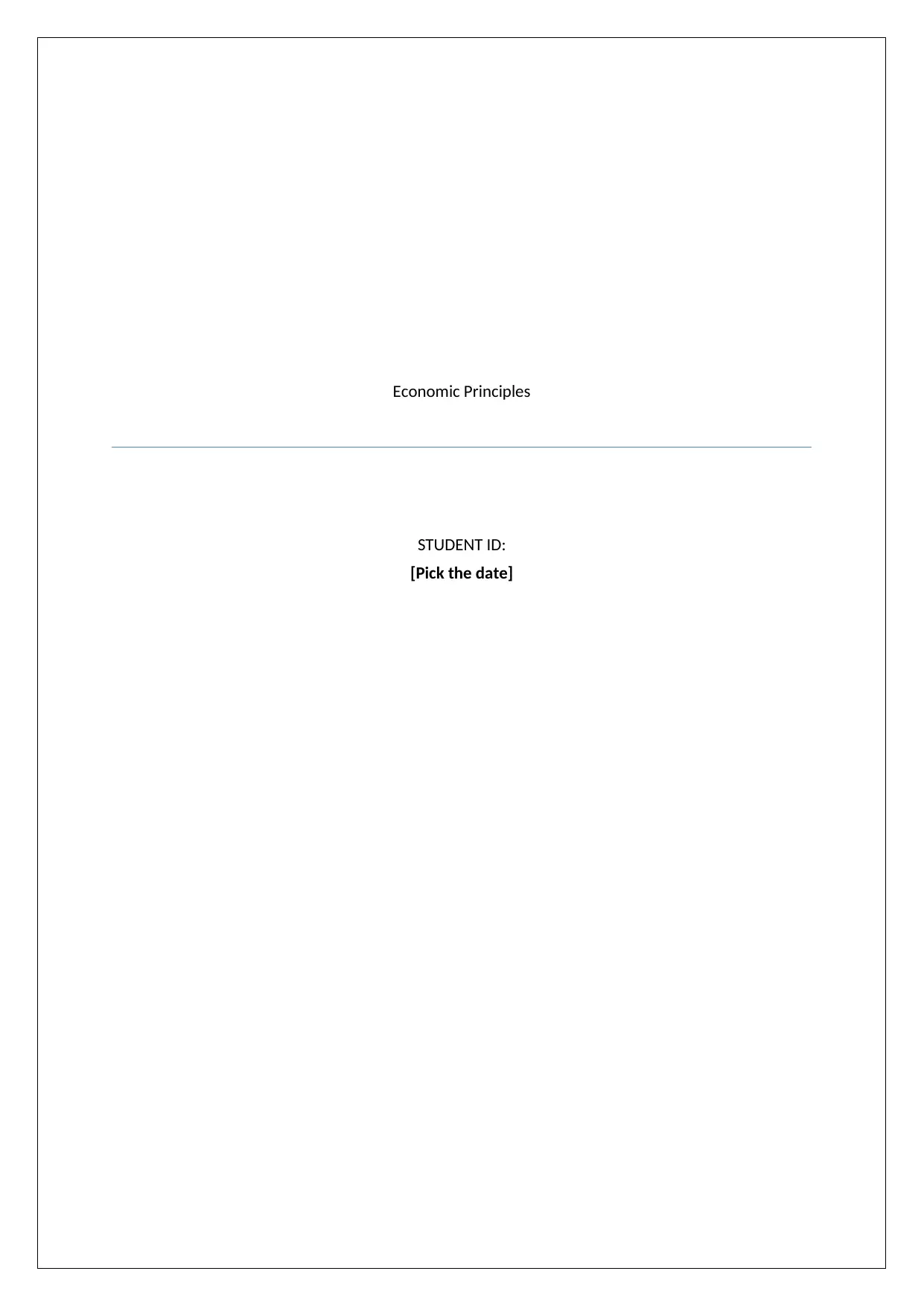
Economic Principles
STUDENT ID:
[Pick the date]
STUDENT ID:
[Pick the date]
Paraphrase This Document
Need a fresh take? Get an instant paraphrase of this document with our AI Paraphraser
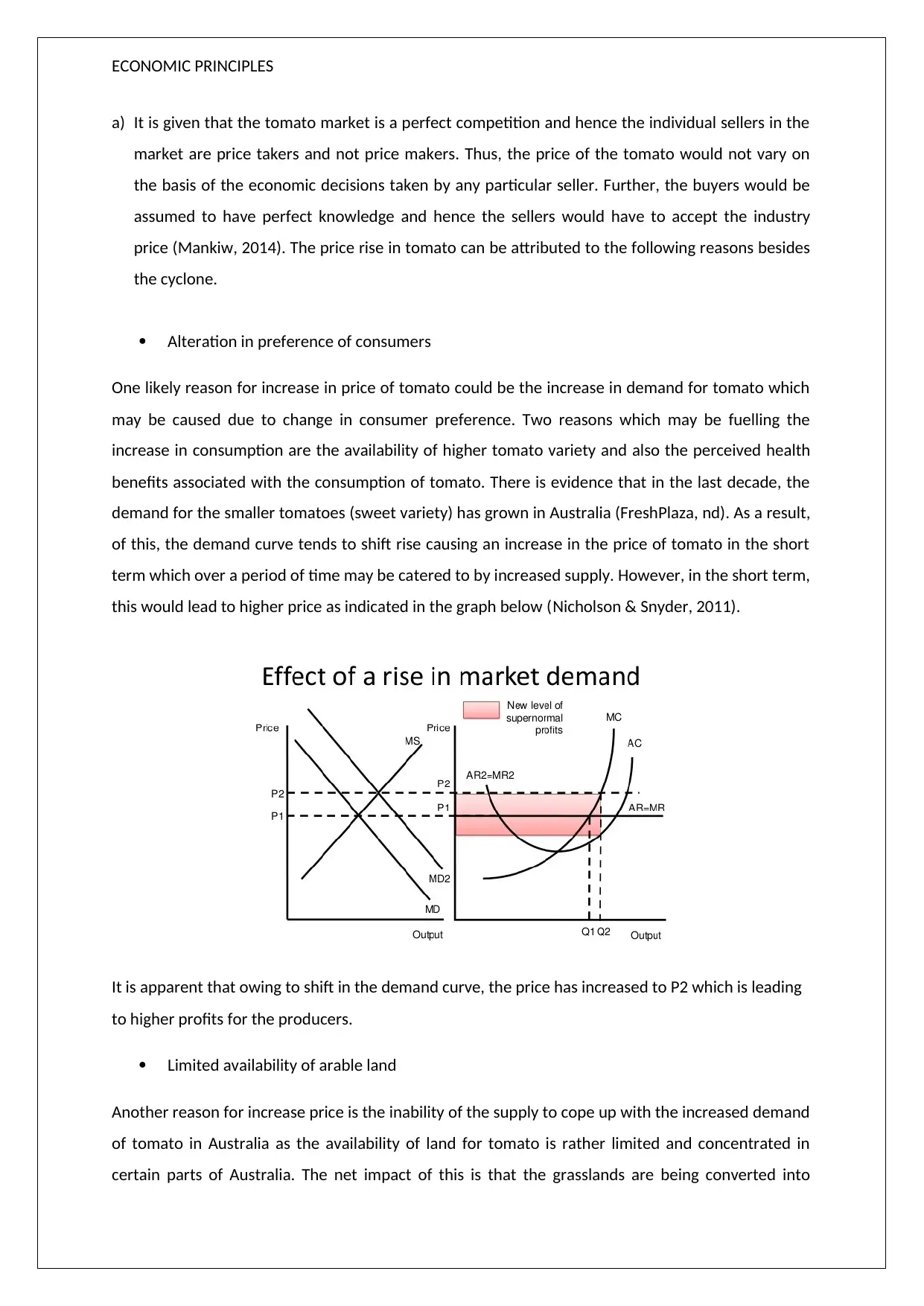
ECONOMIC PRINCIPLES
a) It is given that the tomato market is a perfect competition and hence the individual sellers in the
market are price takers and not price makers. Thus, the price of the tomato would not vary on
the basis of the economic decisions taken by any particular seller. Further, the buyers would be
assumed to have perfect knowledge and hence the sellers would have to accept the industry
price (Mankiw, 2014). The price rise in tomato can be attributed to the following reasons besides
the cyclone.
Alteration in preference of consumers
One likely reason for increase in price of tomato could be the increase in demand for tomato which
may be caused due to change in consumer preference. Two reasons which may be fuelling the
increase in consumption are the availability of higher tomato variety and also the perceived health
benefits associated with the consumption of tomato. There is evidence that in the last decade, the
demand for the smaller tomatoes (sweet variety) has grown in Australia (FreshPlaza, nd). As a result,
of this, the demand curve tends to shift rise causing an increase in the price of tomato in the short
term which over a period of time may be catered to by increased supply. However, in the short term,
this would lead to higher price as indicated in the graph below (Nicholson & Snyder, 2011).
It is apparent that owing to shift in the demand curve, the price has increased to P2 which is leading
to higher profits for the producers.
Limited availability of arable land
Another reason for increase price is the inability of the supply to cope up with the increased demand
of tomato in Australia as the availability of land for tomato is rather limited and concentrated in
certain parts of Australia. The net impact of this is that the grasslands are being converted into
a) It is given that the tomato market is a perfect competition and hence the individual sellers in the
market are price takers and not price makers. Thus, the price of the tomato would not vary on
the basis of the economic decisions taken by any particular seller. Further, the buyers would be
assumed to have perfect knowledge and hence the sellers would have to accept the industry
price (Mankiw, 2014). The price rise in tomato can be attributed to the following reasons besides
the cyclone.
Alteration in preference of consumers
One likely reason for increase in price of tomato could be the increase in demand for tomato which
may be caused due to change in consumer preference. Two reasons which may be fuelling the
increase in consumption are the availability of higher tomato variety and also the perceived health
benefits associated with the consumption of tomato. There is evidence that in the last decade, the
demand for the smaller tomatoes (sweet variety) has grown in Australia (FreshPlaza, nd). As a result,
of this, the demand curve tends to shift rise causing an increase in the price of tomato in the short
term which over a period of time may be catered to by increased supply. However, in the short term,
this would lead to higher price as indicated in the graph below (Nicholson & Snyder, 2011).
It is apparent that owing to shift in the demand curve, the price has increased to P2 which is leading
to higher profits for the producers.
Limited availability of arable land
Another reason for increase price is the inability of the supply to cope up with the increased demand
of tomato in Australia as the availability of land for tomato is rather limited and concentrated in
certain parts of Australia. The net impact of this is that the grasslands are being converted into
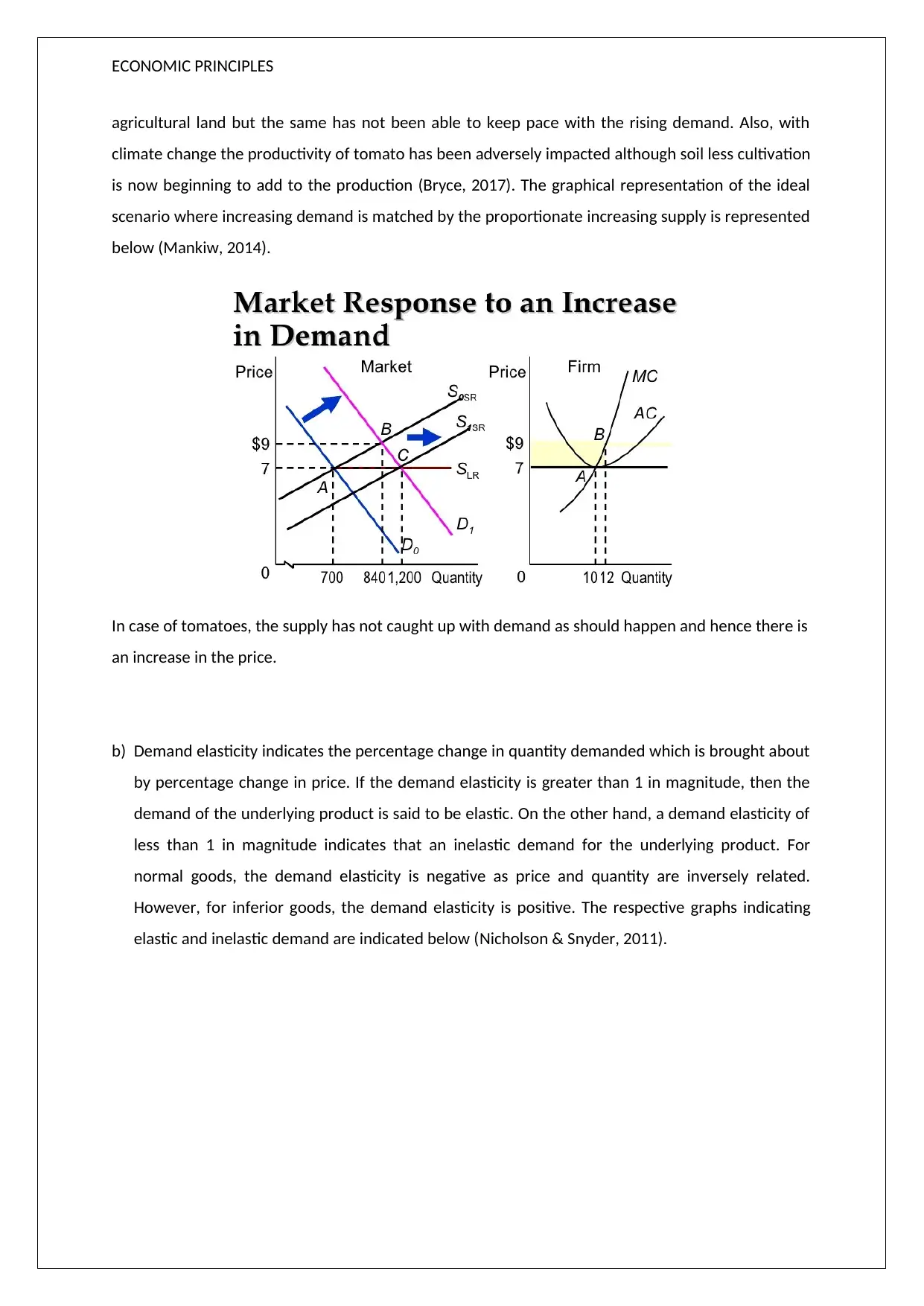
ECONOMIC PRINCIPLES
agricultural land but the same has not been able to keep pace with the rising demand. Also, with
climate change the productivity of tomato has been adversely impacted although soil less cultivation
is now beginning to add to the production (Bryce, 2017). The graphical representation of the ideal
scenario where increasing demand is matched by the proportionate increasing supply is represented
below (Mankiw, 2014).
In case of tomatoes, the supply has not caught up with demand as should happen and hence there is
an increase in the price.
b) Demand elasticity indicates the percentage change in quantity demanded which is brought about
by percentage change in price. If the demand elasticity is greater than 1 in magnitude, then the
demand of the underlying product is said to be elastic. On the other hand, a demand elasticity of
less than 1 in magnitude indicates that an inelastic demand for the underlying product. For
normal goods, the demand elasticity is negative as price and quantity are inversely related.
However, for inferior goods, the demand elasticity is positive. The respective graphs indicating
elastic and inelastic demand are indicated below (Nicholson & Snyder, 2011).
agricultural land but the same has not been able to keep pace with the rising demand. Also, with
climate change the productivity of tomato has been adversely impacted although soil less cultivation
is now beginning to add to the production (Bryce, 2017). The graphical representation of the ideal
scenario where increasing demand is matched by the proportionate increasing supply is represented
below (Mankiw, 2014).
In case of tomatoes, the supply has not caught up with demand as should happen and hence there is
an increase in the price.
b) Demand elasticity indicates the percentage change in quantity demanded which is brought about
by percentage change in price. If the demand elasticity is greater than 1 in magnitude, then the
demand of the underlying product is said to be elastic. On the other hand, a demand elasticity of
less than 1 in magnitude indicates that an inelastic demand for the underlying product. For
normal goods, the demand elasticity is negative as price and quantity are inversely related.
However, for inferior goods, the demand elasticity is positive. The respective graphs indicating
elastic and inelastic demand are indicated below (Nicholson & Snyder, 2011).
⊘ This is a preview!⊘
Do you want full access?
Subscribe today to unlock all pages.

Trusted by 1+ million students worldwide
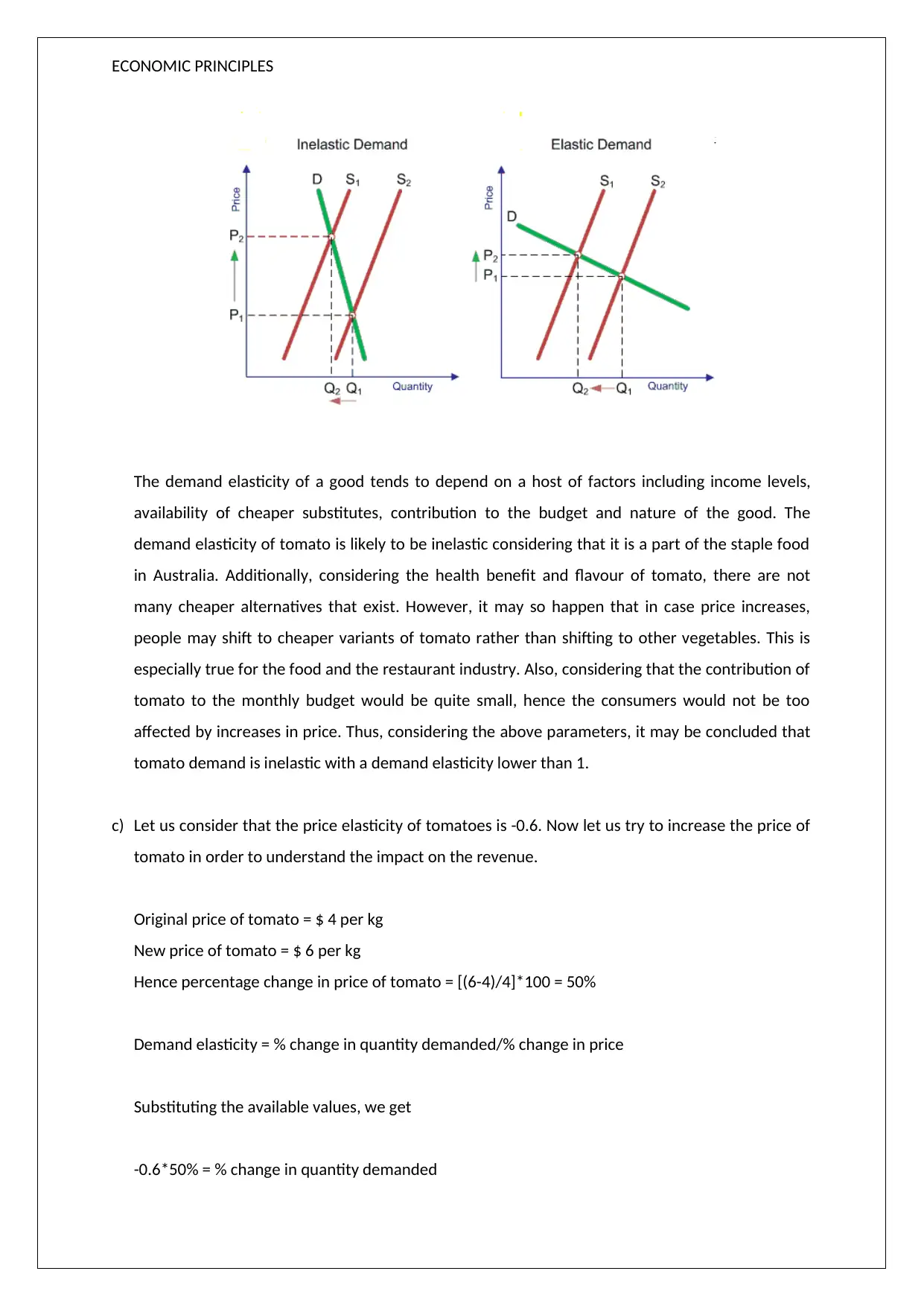
ECONOMIC PRINCIPLES
The demand elasticity of a good tends to depend on a host of factors including income levels,
availability of cheaper substitutes, contribution to the budget and nature of the good. The
demand elasticity of tomato is likely to be inelastic considering that it is a part of the staple food
in Australia. Additionally, considering the health benefit and flavour of tomato, there are not
many cheaper alternatives that exist. However, it may so happen that in case price increases,
people may shift to cheaper variants of tomato rather than shifting to other vegetables. This is
especially true for the food and the restaurant industry. Also, considering that the contribution of
tomato to the monthly budget would be quite small, hence the consumers would not be too
affected by increases in price. Thus, considering the above parameters, it may be concluded that
tomato demand is inelastic with a demand elasticity lower than 1.
c) Let us consider that the price elasticity of tomatoes is -0.6. Now let us try to increase the price of
tomato in order to understand the impact on the revenue.
Original price of tomato = $ 4 per kg
New price of tomato = $ 6 per kg
Hence percentage change in price of tomato = [(6-4)/4]*100 = 50%
Demand elasticity = % change in quantity demanded/% change in price
Substituting the available values, we get
-0.6*50% = % change in quantity demanded
The demand elasticity of a good tends to depend on a host of factors including income levels,
availability of cheaper substitutes, contribution to the budget and nature of the good. The
demand elasticity of tomato is likely to be inelastic considering that it is a part of the staple food
in Australia. Additionally, considering the health benefit and flavour of tomato, there are not
many cheaper alternatives that exist. However, it may so happen that in case price increases,
people may shift to cheaper variants of tomato rather than shifting to other vegetables. This is
especially true for the food and the restaurant industry. Also, considering that the contribution of
tomato to the monthly budget would be quite small, hence the consumers would not be too
affected by increases in price. Thus, considering the above parameters, it may be concluded that
tomato demand is inelastic with a demand elasticity lower than 1.
c) Let us consider that the price elasticity of tomatoes is -0.6. Now let us try to increase the price of
tomato in order to understand the impact on the revenue.
Original price of tomato = $ 4 per kg
New price of tomato = $ 6 per kg
Hence percentage change in price of tomato = [(6-4)/4]*100 = 50%
Demand elasticity = % change in quantity demanded/% change in price
Substituting the available values, we get
-0.6*50% = % change in quantity demanded
Paraphrase This Document
Need a fresh take? Get an instant paraphrase of this document with our AI Paraphraser
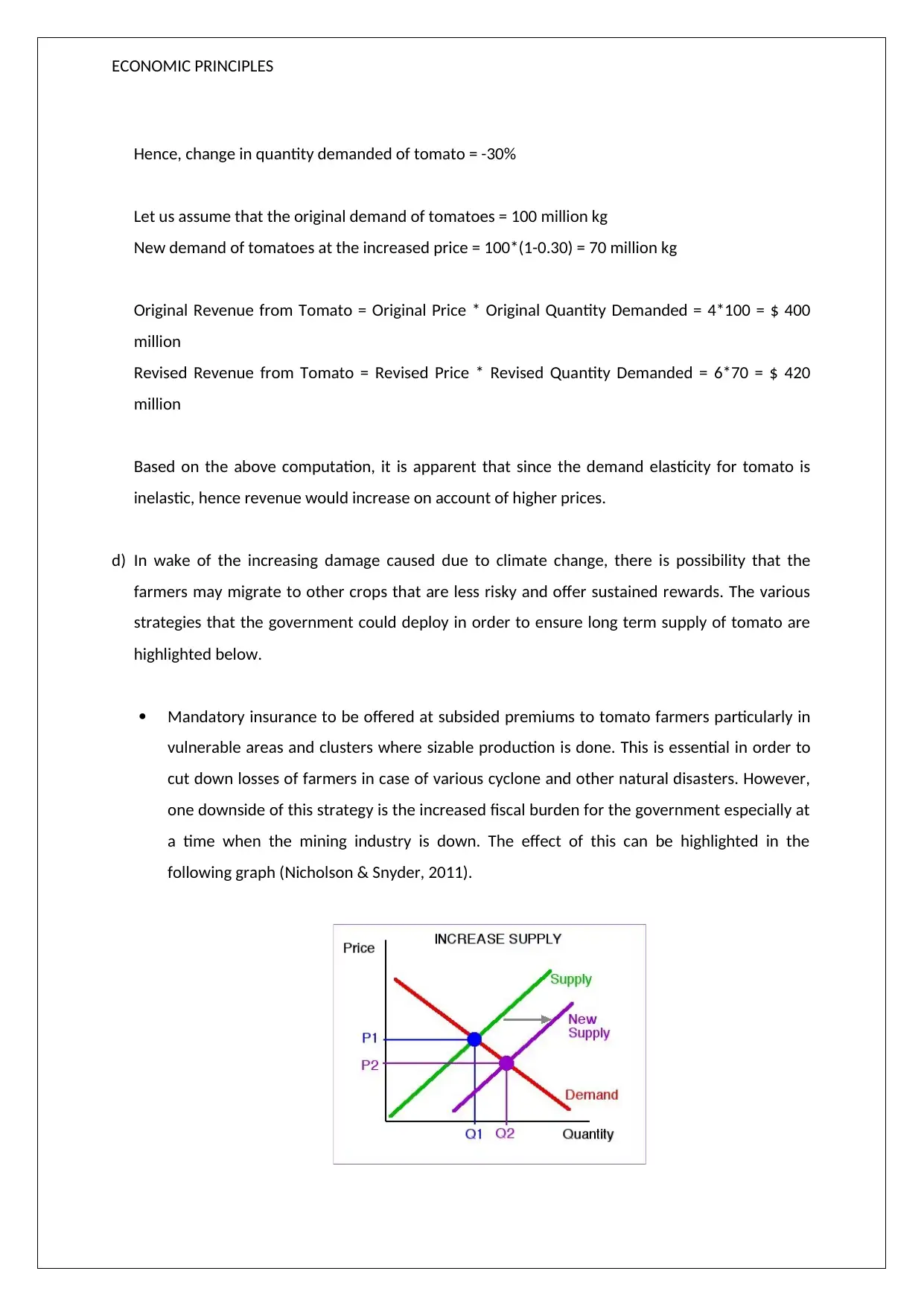
ECONOMIC PRINCIPLES
Hence, change in quantity demanded of tomato = -30%
Let us assume that the original demand of tomatoes = 100 million kg
New demand of tomatoes at the increased price = 100*(1-0.30) = 70 million kg
Original Revenue from Tomato = Original Price * Original Quantity Demanded = 4*100 = $ 400
million
Revised Revenue from Tomato = Revised Price * Revised Quantity Demanded = 6*70 = $ 420
million
Based on the above computation, it is apparent that since the demand elasticity for tomato is
inelastic, hence revenue would increase on account of higher prices.
d) In wake of the increasing damage caused due to climate change, there is possibility that the
farmers may migrate to other crops that are less risky and offer sustained rewards. The various
strategies that the government could deploy in order to ensure long term supply of tomato are
highlighted below.
Mandatory insurance to be offered at subsided premiums to tomato farmers particularly in
vulnerable areas and clusters where sizable production is done. This is essential in order to
cut down losses of farmers in case of various cyclone and other natural disasters. However,
one downside of this strategy is the increased fiscal burden for the government especially at
a time when the mining industry is down. The effect of this can be highlighted in the
following graph (Nicholson & Snyder, 2011).
Hence, change in quantity demanded of tomato = -30%
Let us assume that the original demand of tomatoes = 100 million kg
New demand of tomatoes at the increased price = 100*(1-0.30) = 70 million kg
Original Revenue from Tomato = Original Price * Original Quantity Demanded = 4*100 = $ 400
million
Revised Revenue from Tomato = Revised Price * Revised Quantity Demanded = 6*70 = $ 420
million
Based on the above computation, it is apparent that since the demand elasticity for tomato is
inelastic, hence revenue would increase on account of higher prices.
d) In wake of the increasing damage caused due to climate change, there is possibility that the
farmers may migrate to other crops that are less risky and offer sustained rewards. The various
strategies that the government could deploy in order to ensure long term supply of tomato are
highlighted below.
Mandatory insurance to be offered at subsided premiums to tomato farmers particularly in
vulnerable areas and clusters where sizable production is done. This is essential in order to
cut down losses of farmers in case of various cyclone and other natural disasters. However,
one downside of this strategy is the increased fiscal burden for the government especially at
a time when the mining industry is down. The effect of this can be highlighted in the
following graph (Nicholson & Snyder, 2011).
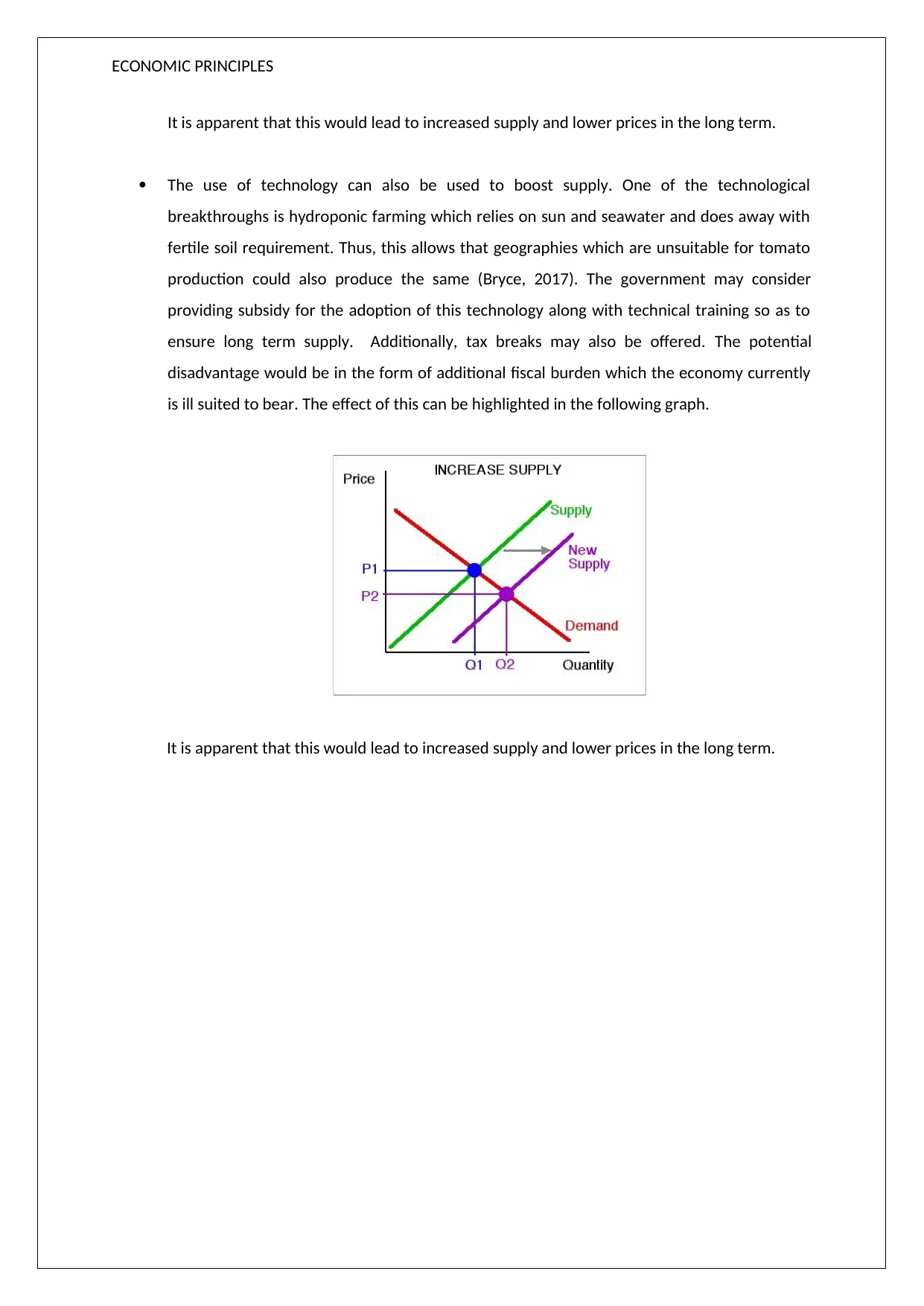
ECONOMIC PRINCIPLES
It is apparent that this would lead to increased supply and lower prices in the long term.
The use of technology can also be used to boost supply. One of the technological
breakthroughs is hydroponic farming which relies on sun and seawater and does away with
fertile soil requirement. Thus, this allows that geographies which are unsuitable for tomato
production could also produce the same (Bryce, 2017). The government may consider
providing subsidy for the adoption of this technology along with technical training so as to
ensure long term supply. Additionally, tax breaks may also be offered. The potential
disadvantage would be in the form of additional fiscal burden which the economy currently
is ill suited to bear. The effect of this can be highlighted in the following graph.
It is apparent that this would lead to increased supply and lower prices in the long term.
It is apparent that this would lead to increased supply and lower prices in the long term.
The use of technology can also be used to boost supply. One of the technological
breakthroughs is hydroponic farming which relies on sun and seawater and does away with
fertile soil requirement. Thus, this allows that geographies which are unsuitable for tomato
production could also produce the same (Bryce, 2017). The government may consider
providing subsidy for the adoption of this technology along with technical training so as to
ensure long term supply. Additionally, tax breaks may also be offered. The potential
disadvantage would be in the form of additional fiscal burden which the economy currently
is ill suited to bear. The effect of this can be highlighted in the following graph.
It is apparent that this would lead to increased supply and lower prices in the long term.
⊘ This is a preview!⊘
Do you want full access?
Subscribe today to unlock all pages.

Trusted by 1+ million students worldwide
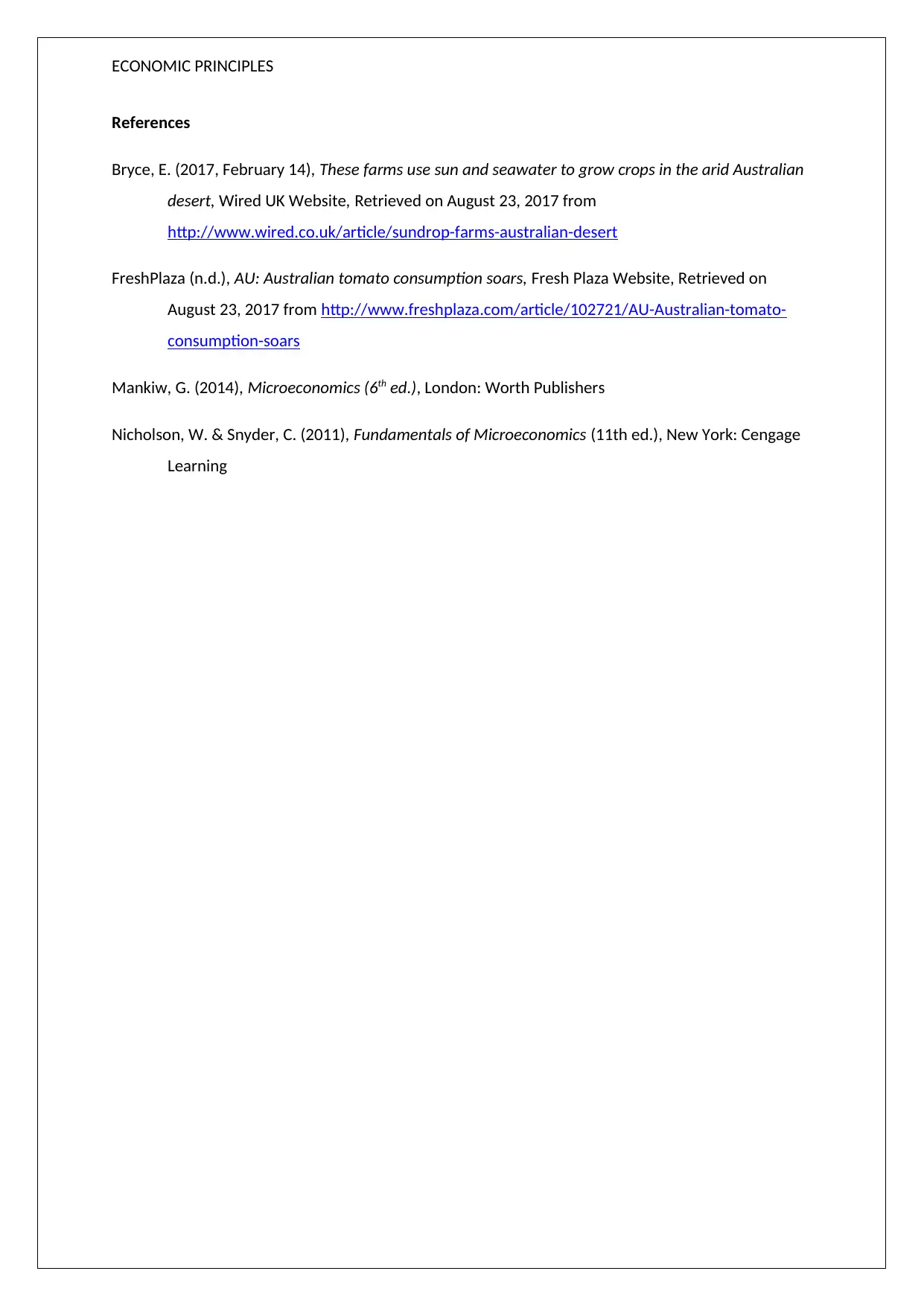
ECONOMIC PRINCIPLES
References
Bryce, E. (2017, February 14), These farms use sun and seawater to grow crops in the arid Australian
desert, Wired UK Website, Retrieved on August 23, 2017 from
http://www.wired.co.uk/article/sundrop-farms-australian-desert
FreshPlaza (n.d.), AU: Australian tomato consumption soars, Fresh Plaza Website, Retrieved on
August 23, 2017 from http://www.freshplaza.com/article/102721/AU-Australian-tomato-
consumption-soars
Mankiw, G. (2014), Microeconomics (6th ed.), London: Worth Publishers
Nicholson, W. & Snyder, C. (2011), Fundamentals of Microeconomics (11th ed.), New York: Cengage
Learning
References
Bryce, E. (2017, February 14), These farms use sun and seawater to grow crops in the arid Australian
desert, Wired UK Website, Retrieved on August 23, 2017 from
http://www.wired.co.uk/article/sundrop-farms-australian-desert
FreshPlaza (n.d.), AU: Australian tomato consumption soars, Fresh Plaza Website, Retrieved on
August 23, 2017 from http://www.freshplaza.com/article/102721/AU-Australian-tomato-
consumption-soars
Mankiw, G. (2014), Microeconomics (6th ed.), London: Worth Publishers
Nicholson, W. & Snyder, C. (2011), Fundamentals of Microeconomics (11th ed.), New York: Cengage
Learning
1 out of 7
Related Documents
Your All-in-One AI-Powered Toolkit for Academic Success.
+13062052269
info@desklib.com
Available 24*7 on WhatsApp / Email
![[object Object]](/_next/static/media/star-bottom.7253800d.svg)
Unlock your academic potential
Copyright © 2020–2025 A2Z Services. All Rights Reserved. Developed and managed by ZUCOL.




